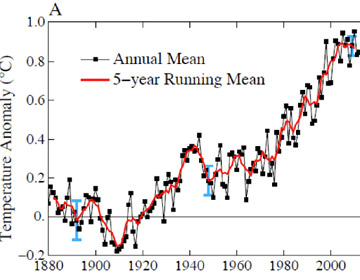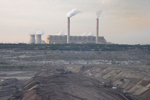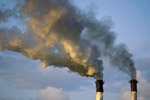World must aim for one degrees Celsius warming, instead of two say leading scientists.
Two degrees is too much: that’s the conclusion of a landmark new paper by top economists and climatologists, including James Hansen formerly of NASA. The paper, appearing in the open-access journal PLoS ONE, argues that global society must aim for only one degree Celsius of warming above pre-industrial levels to avoid the worst impact of climate change, and not the two degrees Celsius agreed on by the world’s governments. But given that the world’s governments are not yet on track to even achieve the two degree target, how could we lock in just one? A combination of renewable energy, nuclear power, and, most importantly, a rising price on carbon emissions, according to the eighteen scientists.
“Rapid emissions reduction is required to restore Earth’s energy balance and avoid ocean heat uptake that would practically guarantee irreversible effects,” the scientists write. “Continuation of high fossil fuel emissions, given current knowledge of the consequences, would be an act of extraordinary witting intergenerational injustice.”
 Global temperatures have already risen approximately 0.8 degrees Celsius. Graph courtesy of Hansen et al. |
The scientists argue that allowing the climate to warm two degrees Celsius would lead to massive and devastating impacts, including rising sea levels that could hit six meters above current levels within a few hundred years, essentially swamping the world’s coastal populations. Evidence for this lies in the Eemian period, when global temperatures were around 2 degrees Celsius warmer than today.
“More generally, humanity and nature, the modern world as we know it, is adapted to the Holocene climate that has existed more than 10,000 years. Warming of 1 degree Celsius relative to 1880–1920 keeps global temperature close to the Holocene range,” the researchers write.
Moreover, the scientists warn that allowing global temperatures to rise two degrees would lead to “slow” warming feedbacks that eventually push our climate up three to four degrees Celsius in total, unleashing catastrophic climate change that would change the face of the Earth entirely.
 Annual carbon emissions from fossil fuel sources. Coal is the largest contributor to climate change. Graph courtesy of Hansen et al. |
Already, the researchers contend that the impacts of current warming (at 0.8 degrees Celsius above pre-industrial levels) have proven far more severe than predicted: rapidly declining Arctic sea ice, acidifying oceans, migrating species, loss of mountain glaciers, and an increase in deadly heatwaves.
“Mega-heatwaves, such as those in Europe in 2003, the Moscow area in 2010, Texas and Oklahoma in 2011, Greenland in 2012, and Australia in 2013 have become more widespread with the increase demonstrably linked to global warming,” they note as an example.
In the end, the scientists dub the governments’ current plan to keep temperatures from rising above two degrees Celsius as “foolhardy.” But how would we achieve this new, much more ambitious target?
An impossible task or an opportunity?

Sunrise in Hawaii. Photo by: Rhett A. Butler.
In order to keep temperatures from rising above one degree Celsius, the scientists propose bold action. According to them, the crisis demands a decrease in fossil fuel carbon emissions of six percent annually beginning this year. If that sounds like a lot—and it is—every year that the world’s puts off slashing carbon emissions will require even steeper annual cuts. They also say cumulative carbon emission from fossil fuels must not exceed 500 gigatons. To date, 370 gigatons have already been emitted with another 10 gigatons added every year currently.
“It is urgent that large, long-term emission reductions begin soon. Even if a 6 percent/year reduction rate and 500 gigatons of carbon are not achieved, it makes a huge difference when reductions begin. There is no practical justification for why emissions necessarily must even approach 1000 gigatons of carbon,” the scientists write. The 1,000 gigatons of carbon figure comes from the The Intergovernmental Panel on Climate Change (IPCC), which recently laid out a carbon budget for achieving the two degree target.
 Atmospheric CO2 if fossil fuel emissions are reduced at 6 percent versus 2 percent annual rates starting 2013, including a 100 gigaton of carbon sequestration due to reforestation. Graph courtesy of Hansen et al. |
Furthermore, an agricultural transformation coupled with a vast reforestation program must take place worldwide in order to lock in 100 gigatons of carbon in the world’s forests and soils. According to the paper, if fossil fuel emissions are aggressively curbed and forests allowed to grow back then the world has a good chance of seeing carbon in the atmosphere drop from the current 393 parts per million (ppm) back to 350 ppm by the end of the century. Most scientists view 350 ppm (and declining) as an acceptable number for a generally benign climate.
To achieve this, the most important missing element, according to the paper, is a steadily rising carbon fee. To make such a fee more politically feasible, proceed from the carbon fee could be redistributed to the general public.
“If the carbon fee rises continually and predictably, the resulting energy transformations should generate many jobs, a welcome benefit for nations still suffering from long-standing economic recession,” the researchers write.
They add that the current cheapness of fossil fuel energy is really an economic smokescreen.
“Fossil fuels are cheap only because they do not pay their costs to society and receive large direct and indirect subsidies,” the researchers write. “Air and water pollution from fossil fuel extraction and use have high costs in human health, food production, and natural ecosystems, killing more than 1,000,000 people per year and affecting the health of billions of people, with costs borne by the public.”
A rising carbon price would not only lead nations to increasingly adopt less carbon-intensive fuel sources, but to greater innovation in the energy sector. Once a carbon price is in place, the scientists suggest nations focus on ramping up renewable energy, increasing energy efficiency, pushing research and development of new technologies, and rapidly deploying nuclear power, the last of which is probably the most controversial.
“Nuclear power faces persistent concerns about safety, nuclear waste, and potential weapons proliferation, despite past contributions to mortality prevention and climate change mitigation,” the researchers write, adding that they view future nuclear power plants (third and fourth generation) as more efficient and safer.

Nuclear power plant in Cattenom, France. Nuclear power makes up nearly 75 percent of France’s energy. Some climatologists, including James Hansen, are increasingly vocal that the risks of nuclear power are far less than fossil fuel energy. Photo by: Gralo/Creative Commons 3.0.
“The long-term future of nuclear power will employ ‘fast’ reactors, which utilize 99 percent of the nuclear fuel and can ‘burn’ nuclear waste and excess weapons material,” they contend.
Not only is it possible to keep temperatures from rising one degree Celsius above pre-industrial levels, but it’s economically feasible, according to the scientists. Co-author, Jeffrey Sachs with Columbia University’s Earth Institute, said at a press conference that the cost would be about one percent of GDP a year to decarbonize society, far cheaper than the alternative.
“In terms of economics, comparing a path to decarbonization versus a path of wrecking the planet are not even close,” he noted as reported by Yale360, adding “at low cost, it’s possible to avoid the devastating risks of a continued business-as-usual path.”
 Carbon emission from fossil fuels 1751-2012. Graph courtesy of Hansen et al. |
Yet, governments are showing little sign of tackling climate change with the seriousness that scientists say it deserves.
“Governments and industry are rushing into expanded use of fossil fuels, including unconventional fossil fuels such as tar sands, tar shale, shale gas extracted by hydrofracking, and methane hydrates. […] A case has been made that the absence of effective governmental leadership is related to the effect of special interests on policy, as well as to public relations efforts by organizations that profit from the public’s addiction to fossil fuels,” write the scientists.
At the close of the paper the researchers appeal to the world’s judicial branches and the broader public. They note that government’s judicial branches are less prone to industrial lobbyists and electoral swings, thereby possibly allowing greater clarity on addressing climate change.
“We maintain that failure of governments to effectively address climate change infringes on fundamental rights of young people,” they write, adding that the rising moral dimension of climate change could drive the societal transformation required.
“As with the issue of slavery and civil rights, public recognition of the moral dimensions of human-made climate change may be needed to stir the public’s conscience to the point of action.”
Citations:
- James Hansen, Pushker Kharecha, Makiko Sato, Valerie Masson-Delmotte, Frank Ackerman,
David J. Beerling, Paul J. Hearty, Ove Hoegh-Guldberg, Shi-Ling Hsu, Camille Parmesan,
Johan Rockstrom, Eelco J. Rohling, Jeffrey Sachs, Pete Smith, Konrad Steffen,
Lise Van Susteren, Karina von Schuckmann, James C. Zachos. (2013) Assessing ‘Dangerous Climate Change’: Required
Reduction of Carbon Emissions to Protect Young People, Future Generations and Nature. PLoS ONE 8(12): e81648. doi:10.1371/journal.pone.0081648.
Related articles
Citizen groups walk out of UN Climate Summit to protest lack of ambition
(11/21/2013) Thirteen citizen groups—including Oxfam, Greenpeace, and WWF—have walked out of ongoing climate talks in Warsaw to protest what they view as a lack of ambition and long-stalled progress on combating global climate change. Nearly 200 governments are currently meeting in Warsaw, Poland at the the 19th Conference of the Parties (COP) for the UN Framework Convention on Climate Change (UNFCCC), which is meant to prepare the way for a new agreement in 2015.
The emissions gap and the forest contribution (commentary)

(11/20/2013) Shortly before the Warsaw climate talks, the United Nations Environmental Programme (UNEP) released its Emissions Gap report, highlighting the growing gap between the emissions reductions that are needed to stay below 2 degrees and the trajectory the world is on at the moment. The report clearly identifies forests as one of the most important options to reduce emissions which can be delivered in the short term. While parties urgently need to start phasing out fossil fuels and stop emissions from fossil fuels no later than 2050, protecting forests now can help significantly to keep a realistic chance of staying below 2 degrees.
UN talks tough to global coal industry

(11/19/2013) Yesterday, at the International Coal and Climate Summit—just a couple miles from the ongoing UN Climate Summit—Christiana Figueres delivered a speech unlike anything ever heard at a coal industry meeting before. Figueres, the Executive Director of the UN Framework Convention on Climate Change (UNFCCC), took time off from wrangling world leaders and officials toward a climate agreement to talk tough to an industry currently worth around $3 trillion.
Carbon emissions set to hit new record high in 2013

(11/19/2013) The amount of carbon dioxide emitted into the atmosphere in 2013 is expected to hit a new high of 36 billion tonnes, according to a Carbon Budget released today by the Global Carbon Project (GCP). This is a 2.1 percent rise from 2012 based on data from the same group. ‘We have exhausted about 70 per cent of the cumulative emissions that keep global climate change likely below two degrees,’ said GCP member, Pierre Friedlingstein, with the University of Exeter. ‘In terms of CO2 emissions, we are following the highest climate change scenario of the Intergovernmental Panel on Climate Change released in September.’
Fracking: the good, the bad and the ugly

(11/18/2013) The last few years have ushered in a new national and global awareness of fracking, the 150-year-old technology for extracting natural gas and oil from rock. Fracking, short for hydraulic fracturing, uses ultra-high-pressure slurries to create hairline fractures throughout solid rock. Oil, and more frequently gas, comes rushing out while sand from the mixture holds the fractures open in this nearly alchemical process. As many readers are aware, there are two very divisive schools of thought on fracking. One side touts it as the future of energy. The other derides fracking as inherently toxic and demands its immediate and permanent cessation. Like so many aspects of life, the truth lies somewhere in between.
60,000 protest in Australia to keep carbon price
(11/18/2013) Around 60,000 Australians marched yesterday across the country calling on their government not to go backwards on climate action, according to organizers. Australia has taken a sudden U-turn on climate policy with the election of Prime Minister Tony Abbott in September, including legislation to end its carbon pricing, cutting funding to renewable energies, and obstructing progress at the ongoing UN Climate Summit in Warsaw.
Japan pledges to raise carbon emissions, instead of cutting them
(11/18/2013) In 2009, Japan pledged to cut its carbon emissions by 25 percent based on 1990 levels within 11 years. Four years later—including a nuclear meltdown at Fukushima—and Japan has reset its goal with a new target to cut emissions by 3.8 percent based on 2005 levels at the UN Climate Summit in Warsaw, Poland. But, the new target, which received widespread condemnation when announced on Friday, actually results in a 3.1 percent rise in emissions when viewed from the widely-accepted 1990 baseline.
World’s most vulnerable nation to climate change turns to coal power

(11/18/2013) In October, a global risks analysis company, Maplecroft, named Bangladesh the world’s most vulnerable nation to climate change by 2050. The designation came as little surprise, since Bangladesh’s government and experts have been warning for years of climatic impacts, including rising sea levels, extreme weather, and millions of refugees. However, despite these very public warnings, in recent years the same government has made a sudden turn toward coal power—the most carbon intensive fuel source—with a master plan of installing 15,000 megawatts (MW) of coal energy by 2030, which could potentially increase the country’s current carbon dioxide emissions by 160 percent.
Tiny algae signal big changes for warming Arctic lakes

(11/15/2013) The mighty polar bear has long been the poster child for the effects of global warming in the Arctic, but the microscopic diatom tells an equally powerful story. Diatoms are a type of algae that form the base of the food chain in watery habitats the world over. Disturbances among lake diatoms have exposed the impacts of rapid warming in the Hudson Bay Lowlands of eastern Canada, researchers reported Oct. 9 in the Proceedings of the Royal Society B
Is Australia becoming the new Canada in terms of climate inaction?
(11/14/2013) For many concerned about climate change, Australia has suddenly become the new Canada. With the election of Tony Abbott as Prime Minister in September, the land down under has taken a sudden U-turn on climate policy, including pushing to end its fledgling carbon emissions program which was only implemented in 2012 and cutting funding for renewable energy. These move come at a time when Australia has just undergone its warmest 12 months on record and suffered from record bushfires.
(11/13/2013) In 2011, the top 11 richest carbon emitters spent an estimated $74 billion on fossil fuel subsidies, or seven times the amount spent on fast-track climate financing to developing nations, according to a recent report by the Overseas Development Institute. Worldwide, nations spent over half a trillion dollars on fossil fuel subsidies in 2011 according to the International Energy Agency (IEA).
Philippines’ delegate calls out climate change deniers after Haiyan
(11/12/2013) Yesterday, the Filipino delegate to the ongoing climate summit, Naderev ‘Yeb’ Saño, dared climate change deniers to take a hard look at what’s happening not just in the Philippines, but the whole world. Over the weekend, the Philippines was hit by what may have been the largest typhoon to ever make landfall—Typhoon Haiyan. Reports are still coming in days later, but the death toll may rise to over 10,000 with whole cities simply swept away.
Delegate for the Philippines vows to stop eating at climate summit

(11/11/2013) Following the devastation wrought by Typhoon Haiyan—which is arguably the strongest typhoon to ever make landfall—Filipino delegate, Naderev ‘Yeb’ Saño, has vowed to go on a fast at the UN Climate Summit that opened today in Warsaw, Poland. Saño made the vow during a powerful speech in which he said he would fast, ‘until we stop this madness.’
Bangladesh plans massive coal plant in world’s biggest mangrove forest

(11/11/2013) On October 22nd Bangladeshi and Indian officials were supposed to hold a ceremony laying the foundation stone for the Rampal power plant, a massive new coal-fired plant that will sit on the edge of the Sundarbans, the world’s largest mangrove forest. However, the governments suddenly cancelled the ceremony, instead announcing that the project had already been inaugurated in early October by the countries’ heads of state via a less-ornate Skype call. While the governments say the change was made because of busy schedules, activists contend the sudden scuttling of the ceremony was more likely due to rising pressure against the coal plant, including a five-day march in September that attracted thousands.
Bay Area pledges to slash greenhouse gas emissions by 80 percent by 2050
(11/11/2013) While many of the world’s national governments move tepidly (if at all) to combat climate change, cities are showing increasing leadership. The San Francisco Bay Area’s Air District Board signed off last week on a measure to cut greenhouse gas emissions by 80 percent within less than 40 years time as based on 1990 levels. The measure follows the same goal as an executive order made by California governor, Arnold Schwarzenegger, in 2005.